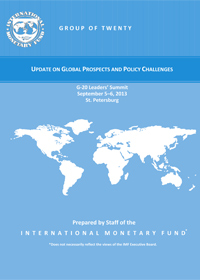Group of Twenty IMF Note-- G-20 Leaders’ Summit
IMF Update on Global Prospects and Policy Challenges
September 5–6, 2013, St. Petersburg
About the Executive Summary
The Following executive summary is from a note by the Staff of the IMF prepared for the September 5–6, 2013 G-20 Leaders’ Summit in St. Petersburg.
Read the Full text ![]()
Executive Summary
This report provides an interim update of global developments and risks since the July Surveillance Note.
Global growth remains subdued but its underlying dynamics are changing. At the global level, major economies are seeing increasingly different growth dynamics and their relative cyclical positions are changing. Recent indicators point to stronger underlying activity in several advanced economies while key emerging economies have slowed. The impulse to global growth is expected to come mainly from the United States in the near term.
Against this background, financial conditions are generally tighter and market pressures have become acute for some emerging economies. Emerging economies were hardest hit following Fed “tapering” remarks and disappointing news about their growth. More recently, market pressures have been concentrated in certain emerging economies with important vulnerabilities. Both push and pull factors appear at work with respect to capital flow reversals and continued heightened market volatility for some—driven by changing expectations of monetary tightening in advanced economies and weaker fundamentals locally in key emerging economies.
Downside risks remain and some have become more prominent. Attention has heightened recently on risks related to recent growth disappointments in emerging economies that could interact with risks related to unwinding of unconventional monetary policies in some advanced economies. This raises more serious risks for certain emerging economies with higher macroeconomic and financial vulnerabilities. Although policymakers continue to show resolve to keep the global economy away from the precipice, the greatest worry may well be a prolonged period of sluggish global growth (a plausible downside).
Strengthened global action is needed to revitalize growth and better manage risks. In an environment of ongoing but incomplete transition to financial stability, changing growth dynamics and concerns about slow growth and high unemployment, achieving a better policy mix through implementation of priorities highlighted during the IMF Spring Meetings remains urgent. Specifically:
- In advanced economies, exceptional monetary accommodation continues to provide important
support to demand but must be complemented by commensurate efforts and progress on other
policies to succeed. In particular, a measured pace of fiscal tightening with good composition,
anchored by credible debt reduction plans, including entitlement reform remains important; while in
the euro area, reversing financial fragmentation and unlocking credit supply through repairing banks’
balance sheets and advancing on a credible banking union remains crucial.
- In emerging economies, cyclical positions and vulnerabilities vary and policy responses will need to be
country specific. Policymakers should allow exchange rates to respond to changing fundamentals but
may need to guard against risks of disorderly adjustment, including through intervention to smooth
excessive volatility. Where monetary policy frameworks are less credible, efforts may need to focus
more on providing a stronger nominal anchor. With weaker growth prospects and potential problems
from prolonged rapid credit growth, the policy framework must be ready to handle possible further
increases in financial instability and risks to growth. Fiscal policy, generally, should allow stabilizers to
work but avoid stimulus unless a major slowdown looms. Gradual consolidation should continue in
countries with large deficits and debt, in part to rebuild buffers.

